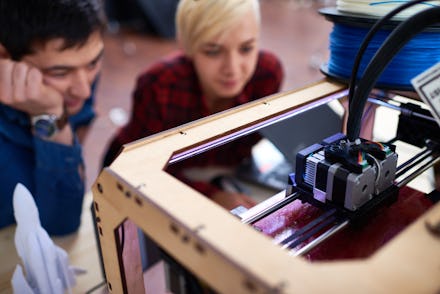Is 3-D printing the key to sustainable manufacturing?

Midway through a long flight over the ocean, the last thing on anyone’s mind is the manufacturing process behind the plane’s engines and airframe components. As long as the flight is comfortable and lands on time, little else matters to the average traveler. But the next time you take to the sky, consider that parts of your plane could have been made using revolutionary 3-D printing technologies that can reduce waste and benefit the environment.
The concept of 3-D printing, also known as additive manufacturing, has been around for some time. And, while it has yet to become the norm in manufacturing, adoption of additive manufacturing has increased massively and is projected to continue to grow over the next few years. For example, in aerospace, in about a decade, Airbus went from zero to 30,000 3-D printed parts and plans to grow that number even further in the coming years, a spokesperson for the company said in an interview.
Some of the most significant benefits 3-D printing offers are cost savings and reduced waste. According to John Hart, associate professor of mechanical engineering at Massachusetts Institute of Technology and director of MIT’s Laboratory for Manufacturing and Productivity, “as an ‘additive’ process, 3-D printing is in many cases more material-friendly than traditional ‘subtractive’ manufacturing.”
(Editor’s note: Hart is a representative for MIT and does not endorse any brands.)
The traditional method of “subtractive manufacturing” essentially carves a part out of a solid block of material, leaving the part’s negative space as wasted material. With 3-D printing, a part is formed from scratch, by depositing one layer of material on top of another, based on a digital model. “In additive processes, in many cases there is little waste, and material can be partially recycled for future uses,” Hart said in an interview.
Arconic, a technology and engineering focused manufacturer, has increasingly adopted 3-D printing into its aerospace manufacturing processes. Don Larsen, the company’s vice president of research and development and advanced manufacturing, shared in a phone interview how the technology has improved their processes.
“Before additive manufacturing, we would use a 10-pound block of material to make a one-pound component,” Larsen said. “With additive manufacturing, we only print the material we need, which saves money, reduces waste and can make the parts lighter — potentially upwards of 50% lighter — which also helps the aircraft run more efficiently.”
A U.S. Department of Energy study confirmed that utilizing additive manufacturing can reduce material needs and costs by up to 90%. Along with waste savings, the DOE also found that 3-D printing can save energy, especially when a component that was previously made by combining several smaller parts is consolidated into one.
“Additive manufacturing can be used to create geometrically complex parts [with] specifically tuned mechanical properties,” Hart said. Before, those parts would have been more difficult to manufacture, taken longer to make and would’ve required more energy, according to Hart.
In addition, if a produced part is noncompliant, Larsen said it can be recycled, and the material can be used again — another key benefit of additive manufacturing. Outside of the metal additive manufacturing realm, recycled consumer plastics have even been utilized to make 3-D printed products.
The technology is also being used for research and development purposes and to help bring new products to market faster. Both Airbus and Arconic use 3-D printing to create prototypes to test and validate concepts, accelerating the development process. It reduces the number of steps required to make patterns for manufacturing purposes, Larsen said.
Of course, there are caveats and limits to what 3-D printing can do. “A 3-D printing machine is not like a photocopier,” Larsen said. “3-D printing is still very complex and requires a deep understanding of metallurgy and the parameters behind the technology, not to mention a lot of testing to produce a high-performance aerospace part.” Arconic and Airbus recently announced joint efforts to advance additive manufacturing of metal airplane parts.
Hart said that adoption of 3-D printing will depend on the same cost-benefit analysis businesses always use — but that the future for the technology is bright. While 3-D printing’s economic potential is evolving, its environmental gains are just beginning to surface. From energy and waste savings to recyclability, once additive manufacturing becomes an industry standard, we will begin to visualize its comprehensive environmental benefits.